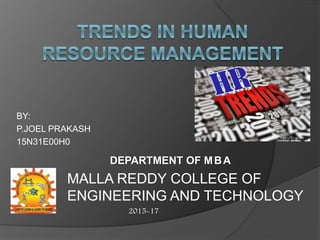
Trends in human resource management
- 1. BY: P.JOEL PRAKASH 15N31E00H0 MALLA REDDY COLLEGE OF ENGINEERING AND TECHNOLOGY DEPARTMENT OF MBA 2015-17
- 2. List of trends Globalization and its implications Work-force Diversity Changing skill requirements Corporate downsizing Continuous improvement programs Re-engineering work processes for improved productivity Contingent workforce Decentralized work sites Employee involvement
- 3. Globalization and its implications Business today doesn’t have national boundaries – it reaches around the world. The rise of multinational corporations places new requirements on human resource managers. The HR department needs to ensure that the appropriate mix of employees in terms of knowledge, skills and cultural adaptability is available to handle global assignments. Human Resource Management (HRM) must also develop mechanisms that will help multicultural individuals work together.
- 4. Work-force Diversity In the past HRM was considerably simpler because our work force was strikingly homogeneous. Today’s work force comprises of people of different gender, age, social class sexual orientation, values, personality characteristics, ethnicity, religion, education, language, physical appearance, martial status, lifestyle, beliefs, ideologies and background characteristics such as geographic origin, tenure with the organization, and economic status and the list could go on. Diversity is critically linked to the organization’s strategic direction. Where diversity flourishes, the potential benefits from better creativity and decision making and greater innovation can be accrued to help increase organization’s competitiveness.
- 5. Changing skill requirements Recruiting and developing skilled labor is important for any company concerned about competitiveness, productivity, quality and managing a diverse work force effectively. Skill deficiencies translate into significant losses for the organization in terms of poor-quality work and lower productivity, increase in employee accidents and customer complaints. Since a growing number of jobs will require more education and higher levels of language than current ones . HRM department will have to devise suitable training and short term programmes to bridge the skill gaps & deficiencies
- 6. Corporate downsizing Whenever an organization attempts to delayer, it is attempting to create greater efficiency. The premise of downsizing is to reduce the number of workers employed by the organization. HRM department has a very important role to play in downsizing. HRM people must ensure that proper communication must take place during this time. They must minimize the negative effects of rumors and ensure that individuals are kept informed with factual data.
- 7. Continuous improvement programs Continuous improvement programs focus on the long term well being of the organization. It is a process whereby an organization focuses on quality and builds a better foundation to serve its customers. This often involves a company wide initiative to improve quality and productivity.
- 8. Re-engineering work processes for improved productivity Re-engineering occurs when more than 70% of the work processes in an organization are evaluated and altered. It requires organizational members to rethink what work should be done, how it is to be done and how to best implement these decisions. Re-engineering changes how organizations do their business and directly affects the employees. Accordingly HRM must have mechanisms in place for employees to get appropriate direction of what to do and what to expect as well as assistance in dealing with the conflict that may permeate the organization. For re-engineering to generate its benefits HRM needs to offer skill training to its employees. Whether it’s a new process, a technology enhancement, working in teams, having more decision making authority, or the like , employees would need new skills as a result of the re-engineering process.
- 9. Contingent workforce Contingent workers are individuals who are typically hired for shorter periods of time. They perform specific tasks that often require special job skills and are employed when an organization is experiencing significant deviations in its workflow. When an organization makes its strategic decision to employ a sizable portion of its workforce from the contingency ranks, several HRM issues come to the forefront. These include being able to have these virtual employees available when needed, providing scheduling options that meet their needs and making decisions about whether or not benefits will be offered to the contingent work force. After all its HRM department’s responsibility to locate and bring into the organization these temporary workers.
- 10. Decentralized work sites Work sites are getting more and more decentralized. Decentralized work sites also offer opportunities that may meet the needs of the diversified workforce. Those who have family responsibilities like child care, or those who have disabilities may prefer to work in their homes rather than travel to the organization’s facility. For HRM, decentralized work sites present a challenge. Much of that challenge revolves around training managers in how to establish and ensure appropriate work quality and on-time completion. Work at home may also require HRM to rethink its compensation policy. Will it pay by the hour, on a salary basis, or by the job performed..
- 11. Employee involvement For today’s organization’s to be successful, there are a number of employee involvement concepts that appear to be accepted. These are delegation, participative management, work teams, goal setting, employee training and empowering of employees. HRM has a significant role to play in employee involvement. What is needed is demonstrated leadership as well as supportive management. Employees need to be trained and that’s where human resource management has a significant role to play.
